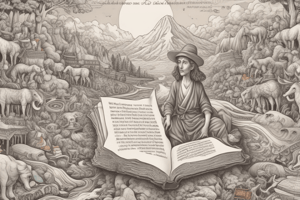Podcast
Questions and Answers
What is the main purpose of identifying the main idea in a passage?
What is the main purpose of identifying the main idea in a passage?
- To memorize every word in the passage
- To summarize the author's central argument (correct)
- To find minor details
- To identify all supporting details
When making an inference, what is one of the key elements used to deduce unstated facts?
When making an inference, what is one of the key elements used to deduce unstated facts?
- Imagination
- Logic (correct)
- Emotions
- Memory
Which type of clue is used to help readers understand the meaning of an unfamiliar word in a text?
Which type of clue is used to help readers understand the meaning of an unfamiliar word in a text?
- Plot clue
- Character clue
- Suspense clue
- Context clue (correct)
What is the primary purpose of drawing conclusions when reading a passage?
What is the primary purpose of drawing conclusions when reading a passage?
When describing characters in a story, what do readers focus on to understand their personalities?
When describing characters in a story, what do readers focus on to understand their personalities?
What is the purpose of context clues in a text?
What is the purpose of context clues in a text?
Drawing conclusions from a text involves:
Drawing conclusions from a text involves:
In the context of character descriptions, what do setting details primarily provide insights into?
In the context of character descriptions, what do setting details primarily provide insights into?
What is the main idea behind using context clues in a text?
What is the main idea behind using context clues in a text?
When drawing conclusions from a text, what does it involve?
When drawing conclusions from a text, what does it involve?
Flashcards are hidden until you start studying
Study Notes
Understanding Reading Comprehension: Main Ideas, Inferences, Context Clues, Drawing Conclusions, Characters, and Settings
Reading comprehension is more than just deciphering written text; it's the ability to extract meaning from what we read by identifying important information, making connections between ideas, and forming interpretations. Let's delve into some of its key components — main idea, inference, context clues, drawing conclusions, describing characters, and settings — with examples to help you strengthen your reading skills.
Main Idea
The main idea is the most essential point within a passage and serves as a summary of the author's central argument. When seeking out the main idea, look for sentences containing keywords like "therefore," "thus," "consequently," or "for example." For instance, if you encounter a sentence saying, "As a result, the company's profits increased dramatically because they expanded their consumer base," this indicates that expanding the consumer base is the primary reason for increased profitability.
Inference
Inferring involves using context and logic to deduce unstated facts or implications based on given information. It helps us understand new concepts and expand our knowledge beyond explicit statements found in texts. A simple example could be "John studied engineering, so he must have an interest in technology." This statement implies John will likely enjoy learning about computers and electronic devices even though it isn't explicitly stated in the input.
Context Clues
Context clues refer to hints within a text that aid readers in understanding unfamiliar vocabulary or interpreting relationships among elements in the passage. They may come in various forms such as synonyms, antonyms, analogies, definitions, and word order. By utilizing these cues, one can make accurate predictions concerning unknown terms in a text. Consider the following excerpt: "John was annoyed when Jane decided against going shopping." To better comprehend the situation, we might infer that Jane made a decision opposite to John's preference concerning shopping.
Drawing Conclusions
Drawing conclusions involves synthesizing multiple pieces of information within a text to arrive at a coherent interpretation. As you examine each paragraph, consider how the individual facts relate to one another and formulate an overall picture of the message being conveyed.
For illustrating this concept, let's imagine a section discussing climate change. If the writer mentions several environmental consequences brought forth due to global warming – ice melting, rising sea levels, extreme weather events - along with human activities causing greenhouse gas emissions, a reader would conclude that reducing carbon output can mitigate environmental harm.
Describing Characters & Settings
When analyzing literature, character descriptions allow us to identify traits, emotions, personalities, and perspectives of individuals mentioned in stories, while setting details offer insights regarding time periods, geographic locations, atmospheres, etc. Both aspects enable deeper engagement with literary works through visualization and relatability fostered by descriptive writing.
Consider the opening lines of J.K Rowling's Harry Potter and the Philosopher's Stone: "Mr and Mrs Dursley, of number four Privet Drive, were proud to say that they were perfectly normal, thank you very much." These two sentences quickly establish not only the household's character as rigidly conventional but also set the tone for further developments throughout the narrative.
By developing proficiency in these areas, you significantly improve your skillset for tackling texts accurately and efficiently. And remember, practice makes perfect! Commit to regularly honing your abilities, seeking guidance when needed, and engaging actively with diverse genres to enhance comprehension.
Studying That Suits You
Use AI to generate personalized quizzes and flashcards to suit your learning preferences.




